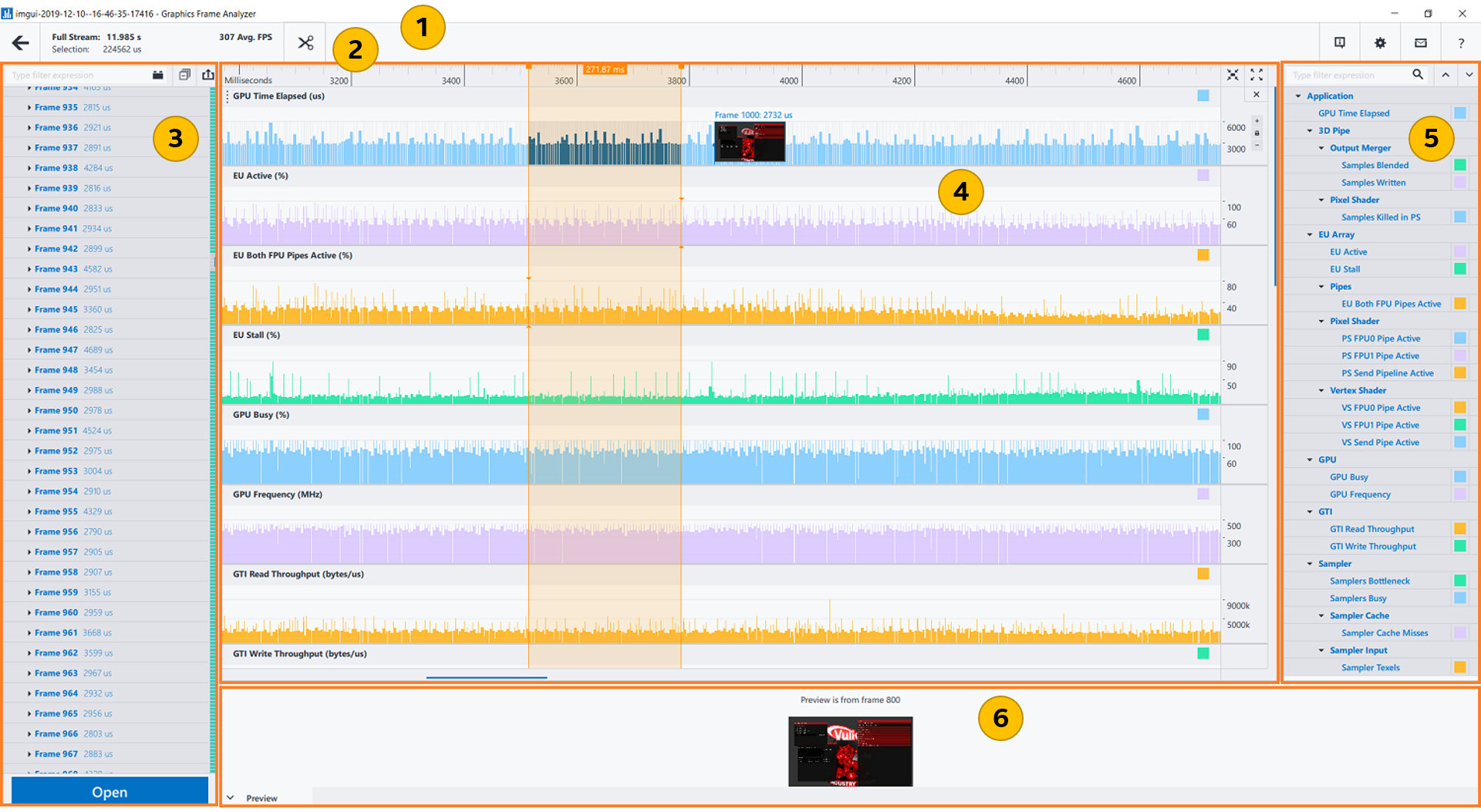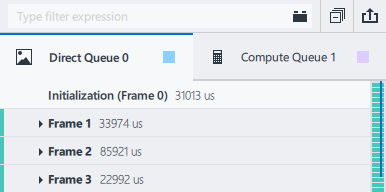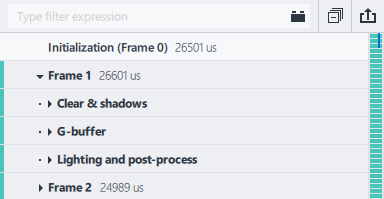Visible to Intel only — GUID: GUID-F3F36FEB-0BBD-41C2-8E21-68E5AD7BAD13
Visible to Intel only — GUID: GUID-F3F36FEB-0BBD-41C2-8E21-68E5AD7BAD13
Multiframe View
To access the Multiframe View window, select a stream for analysis in the Open Frame Capture window, and then click Open, or double-click on a stream preview.

|
Stream Title bar Displays the stream file you opened. The file name contains the application name, capture date, and time in YYYY_MM_DD_HH_MM_SS format. |
|
Main toolbar Displays these details:
Additionally, you can:
|
|
Stream Content pane Displays frames within the stream you opened. |
|
Stream Viewer pane Visualizes stream metrics data, zooms to the selection and zooms out. |
|
Metrics pane Displays metrics collected for the stream you opened. Choose the metrics you want in the Stream Viewer pane. |
|
Preview pane Displays screenshots captured for the stream you opened. To disable or enable screenshot capturing, use the Graphics Monitor OptionsStream tab.
NOTE:
In the Options menu in Graphics Monitor, when you select Create screenshot every X frame/millisecond, you may see this message for the first few frames: “No preview is available for current selection”.
|
Main Toolbar
|
Return to the Open Frame Capture window. |
Stream Overview pane |
Get statistics for the stream you opened:
|
|
Сut the selected frames from the stream and save them into a new stream. This can be useful when a long stream contains only a few frames of interest. Trimming long streams to save relevant frames can save disk space and improve processing time.
NOTE:
Trim Stream supports DirectX 12 only.
|
Message pane |
See messages and non-critical errors, if there are any.
NOTE:
If more than one message is open, use the Up or Down arrows to navigate between messages.
|
|
|
|
Open the Intel® GPA online documentation. |
Stream Content Pane
Type Filter Expression field |
Filter frames by number or duration. Save previous search keywords. You can use the Type Filter Expression field to find specific frames by running Graphics Frame Analyzer plugins. |
|
Open the list of the available Graphics Frame Analyzer plugins, which help you to find specific frames. For example, Frame Search Assistant plugin searches for a frame of the specified duration. |
|
Close all the groups of events and commands for each frame in the Frame List tab, if available. |
|
Save the frame log in CSV format. You can also save the Frame log by pressing Ctrl+S. |
Frame List tab |
Get the list of frames of one rendering context/queue in the CPU execution order. The number of Frame List tabs depends on the number of rendering contexts/queues in the opened stream. To profile an individual frame, double-click the required frame; or click the required frame, and then click Open.
NOTE:
The first frame in a stream cannot be opened for profiling.
For Vulkan-based application streams, the Multiframe View shows subframes:
For applications based on Microsoft DirectX* 12 that use several command queues, the frame list shows each queue in a different tab:
For DirectX 12 applications with command queues that are instrumented with events, each frame can be expanded to view individual events and their details:
|
Open button |
Open the selected frame in the Profiling View window. For Vulkan-based applications, you can select several frames and subframes. |
Stream Viewer Pane
Time line ruler |
Correlate all the displayed frames with the time line. The range of the time line corresponds to the length of the stream in the current zoom level. Depending on the zoom-in level, the time intervals are displayed in seconds, milliseconds, microseconds, or nanoseconds. |
|
Zoom into the time range of selected frames. |
|
Restore the default zoom level. |
Context/Queue bar chart |
Visualize individual frames, their contribution to the overall stream time in the CPU execution order, and keyframes. Keyframe is a saved state of an application, from which you can play back the captured stream.
Bars for selected frames are highlighted on the Context/Queue bar chart. If you only select a part of a frame, the corresponding bar is hatched. Keyframes are shaded grey. By default, streams are visualized on the GPU Time Elapsed track.You can visualize other GPU metrics by selecting a sampling interval other than Frame in the Metrics tab of the Graphics Monitor Options before you start an application on Stream mode. When you set a sampling interval other than Frame, metrics are collected system-wide with the chosen frequency. For DirectX 12, calls from the queues are also shown on the bar chart, represented as markers with downward-pointing triangles. Each marker represents a point in time when a certain call was made. All markers extend downwards, which enables you to correlate calls to the overall frame and GPU metrics, such as GPU Busy (%).
You can also click on each call from the Frame List tab to highlight the corresponding frame and marker on the bar chart. |
Individual chart controls |
Change the vertical scaling of the bar chart by increasing or decreasing the relative height of the bars using the |
Metrics Pane
Type Filter Expression field |
Filter stream file tracks by name or parameters. Save previous search keywords. |
|
Close all unfolded track groups. |
|
Unfold all track groups. |
Metrics list |
See the list of metrics collected for the captured stream file. Click tracks from the Metrics to add them to the Stream Viewer.
NOTE:
To change track color or event color in the Stream Viewer, use the Track Color Modification button (the colored square to the right of the metric).
|


